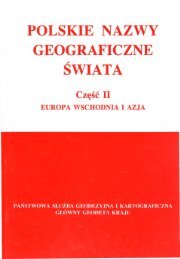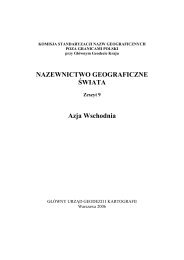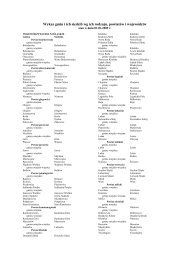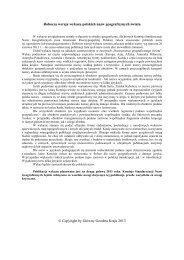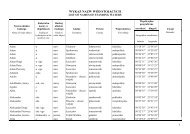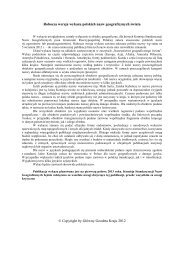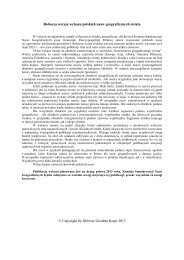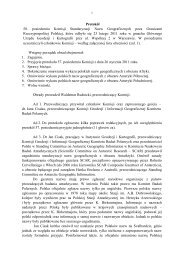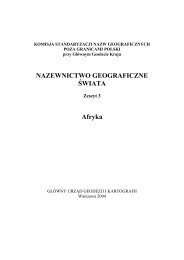TOPONYMIC GUIDELINES OF POLAND - KSNG Nazwy geograficzne
TOPONYMIC GUIDELINES OF POLAND - KSNG Nazwy geograficzne
TOPONYMIC GUIDELINES OF POLAND - KSNG Nazwy geograficzne
Create successful ePaper yourself
Turn your PDF publications into a flip-book with our unique Google optimized e-Paper software.
Kruszwica from krusza ‘pear tree’Krynica ‘źródło’, derived from UkrainianLędziny from lędo ‘arable land’Mogilno from mogiła ‘hill’, compare Magura belowOstrów ‘island’Sopot ‘spring’Szczyrk ‘type of soil’Trzemeszno from trzemcha ‘bird cherry’Uście, Ustka, etc.ujście, Old Polish uście (dualis, i.eused dual number).the formerlySome geographic names, especially in borderland, are of foreignorigin. The majority is of German origin, which is a result of theformer language neighbourhood and also of German settlers comingto the Polish lands since the Middle Ages. Also, German namesappeared in western and southern Polish lands after the fall of Polandin the late 18th century, when Prussia and Austria annexed significantareas of the former Poland. These areas belonged to Prussia andAustria until the end of the World War I.Besides the original names, also a number of names establishedby authorities, which were not used by inhabitants of these areas, canbe found on maps published during this time. During the Nazioccupation a large number of Polish geographic names was changedto German (e.g. Oświęcim to Auschwitz).Names of German origin (e.g. Olsztyn) are also common innortheastern part of Poland, which is a result of the Teutonic Knights’conquest in the Middle Ages.German traces can be also found in roots of certain geographicnames (e.g. Rychwałd, Szymbark, Czorsztyn, compare the Germannames – Wald, Burg, Stein),andalsoinGermanizedspellingsofformer Slavic names (e.g. Opole – Oppeln, Wrocław – Breslau).In borderlands many names originate from the neighbouringlanguages, e.g. Eastern Slavic forms exist along the eastern border(e.g. villages Berezka, Czystohorb, Dubów), Czech and Slovak ones insouthern part of the country (e.g. rivers Słanica, Mutnik, Branica). Anumber of Romanian names (e.g. Młaka, Magura, Kiczera) can befound in Beskidy Mountains, which is a result of the medieval23



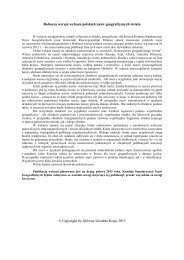
![Wykaz nazw miejscowości do mapy [plik pdf] - KSNG Nazwy ...](https://img.yumpu.com/51618887/1/184x260/wykaz-nazw-miejscowosci-do-mapy-plik-pdf-ksng-nazwy-.jpg?quality=85)

